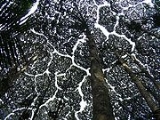
Dryobalanops aromatica
Encyclopedia
Dryobalanops aromatica, commonly known as Borneo Camphor, Camphor Tree, Malay Camphor, or Sumatran Camphor, is a species of plant
in the Dipterocarpaceae
family. The species name aromatica is derived from Latin
(aromaticus = spice-like) and refers to the smell of the dammar (resin). This species was one of the main sources of camphor and attracted early Arab traders to Borneo, at that time being worth more than gold, and used for incense and perfumes .
It is found in Sumatra, Peninsular Malaysia and Borneo.
It is a large emergent tree, up to 65 m or even 75 m tall, found in mixed dipterocarp forests on deep humic yellow sandy soils. It is a heavy hardwood sold under the trade names of Kapur. It is recorded from at least two protected areas (Lambir and Gunung Mulu
National Parks).
Plant
Plants are living organisms belonging to the kingdom Plantae. Precise definitions of the kingdom vary, but as the term is used here, plants include familiar organisms such as trees, flowers, herbs, bushes, grasses, vines, ferns, mosses, and green algae. The group is also called green plants or...
in the Dipterocarpaceae
Dipterocarpaceae
Dipterocarpaceae is a family of 17 genera and approximately 500 species of mainly tropical lowland rainforest trees. The family name, from the type genus Dipterocarpus, is derived from Greek and refers to the two-winged fruit...
family. The species name aromatica is derived from Latin
Latin
Latin is an Italic language originally spoken in Latium and Ancient Rome. It, along with most European languages, is a descendant of the ancient Proto-Indo-European language. Although it is considered a dead language, a number of scholars and members of the Christian clergy speak it fluently, and...
(aromaticus = spice-like) and refers to the smell of the dammar (resin). This species was one of the main sources of camphor and attracted early Arab traders to Borneo, at that time being worth more than gold, and used for incense and perfumes .
It is found in Sumatra, Peninsular Malaysia and Borneo.
It is a large emergent tree, up to 65 m or even 75 m tall, found in mixed dipterocarp forests on deep humic yellow sandy soils. It is a heavy hardwood sold under the trade names of Kapur. It is recorded from at least two protected areas (Lambir and Gunung Mulu
Gunung Mulu National Park
Gunung Mulu National Park near Miri, Sarawak, Malaysian Borneo, is a UNESCO World Heritage Site that encompasses incredible caves and karst formations in a mountainous equatorial rainforest setting...
National Parks).

